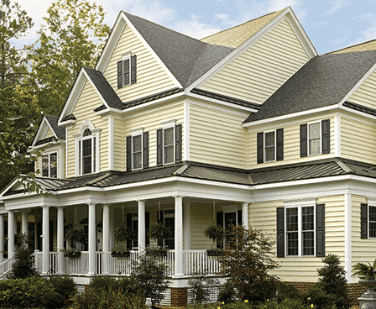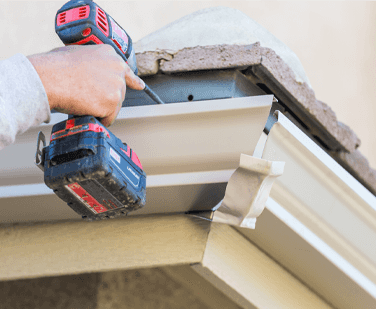Ice Dam Prevention in Maryland
The Winter of 2016 saw a major snowstorm that ravaged Baltimore, all of Maryland and much of the coastal north east. As many unfortunate homeowners learn during every major snowstorm, the resulting damage from ice dams can easily cost thousands of dollars, especially if the snow is allowed to remain on the affected roof for a long time.
What is an Ice Dam?
On the outside, you will see gutters torn and damaged, shingles that are broken and falling off, and even paint that’s peeling. What you do not immediately see is the underlying damage to the deck and in the attic including wet insulation, which if not taken care of right away, can become moldy, damaged sheet-rock in the walls, and major wood and plaster rotting issues. As you can guess, preventing ice dams in the first place, or removing them as quickly as possible is essential for the well being of your property.
Here are some preventive measures to protect your dwelling, as well as understanding how the ice dams form; When the snow falls onto your roof, it can melt when it comes into contact with warmer surfaces of the roof. This may happen when the warm air and heat escapes from your home through the attic floor and rises up to the peak of the roof, which is what causes the melting of the snow. When the melted water reaches the colder eaves of the roof, it refreezes forming a wall of ice, which blocks the runoff of the rest of melted snow. Thus, the melted water has no where to runoff but to rise up underneath the shingles, which is how it can get inside your home, damaging not only your shingles, but also causing major long-term damage.
- Snow Rake – It’s important to remove snow from your roof before it has the time to melt and refreeze. At the same time, you have to be careful not to damage the shingles that lie underneath. They often come with rollers along the bottom to prevent damage to the roof when you’re removing the snow. Some snow rakes feature a metal rod to help cut snow when it has hardened and make the removal easier. Average cost is between $50 and $100, which is an affordable option for most property owners.
- Ice Melting Heat Cables – This product is one of the most popular options for preventing ice dams, however it does not make it the best long-term option. You must access onto the roof eaves in order to install the cables. It’s recommended to place them in a zigzag pattern along the lower edge of the roof as well as near the gutters. Many homeowners hire a contractor to do the work, but it is possible to do it yourself, if you are comfortable with working at heights and using the ladder. The price for heat cables may range from $50 to $100, plus the cost of installation, which can be significant if you hire a specialist. In fact, you can expect to pay anywhere from $1,000 to $2,500 for a professional installation of a self-regulating ice-melting heating-cable system.
- Blown-in Attic Insulation – Preventing heat loss in the attic to improve energy efficiency is only one reason to increase the amount of insulation you have. It also prevents ice dams. Blown-in insulation is the easiest method, and a straightforward process for DIY homeowners. You just have to purchase the insulation and rent a machine to blow it in. The cost depends on how much square footage you’re covering, but it averages around $700 to $800 for 1,000 square feet. If you choose to go this route, make sure you leave the soffit vents unblocked!
- Ventilation Upgrade – Poor ventilation is the cause of many issues with heat loss and ice dams. Certain types of roofs are more susceptible to this problem, but it can be fixed with bringing your attic’s ventilation to an adequate level. The type of vent needed will depend on the exact situation, but you may need a ridge vent, if your roof has soffit vents, or soffit repairs for blocked soffit intakes. – This can sometimes be the unintentional result of poorly-done attic floor insulation. You’ll have to consult a professional to properly remedy any major attic ventilation issues. Expect to pay between $1,500 and $2,000 for a new ridge vent, or several hundred dollars to re-open the soffit vents if they are blocked.
- Ice Belt Metal Panels – Many roofs are made of shingles, which work well to remove water until it starts to travel upward. To take a more pro-active approach in preventing ice dams, you can install ice belt metal panels, which are installed along the eaves to block water. They are often made of aluminum and sold in short panels of about three to four feet in length. You would need to remove a few rows of shingles from the eaves of the roof in order to install the ice belt metal panels. The cost is about $45 to $70 per linear foot, installed. If you choose to go this route, it’s best to install them before you put a new roof on, but it can be done at any point as long as your asphalt roof is still in good shape.
- Add A Metal Roof – Solve all of your ice dam problems with a new metal roof. While this isn’t a cheap solution, it does offer long-term benefits. Metal tiles or shingle are an option along with the continuous standing seam panels. This option requires professional installation and will cost $10,000 to $25,000 or more, but it takes care of the issue for many years.
- Integrate Heating/Ice Melting Panels – This professional-grade product will last for a long time, but they are expensive to buy and install. They can add quite a bit to your monthly utility costs, because they are plugged into an electrical source. This solution is mainly for those homes which have not had much success with other methods or if you want a long-term system and you aren’t worried about ongoing costs. Pricing ranges widely because of the monthly electricity costs, so expect to spend thousands of dollars over the lifetime of the product. Average price is $20 or more per foot for these systems, plus the cost of installation.
- Caulk to Seal Air Leaks – A simple, but effective fix for some of the warm leak issues. Caulk can be applied around vent pipes and electrical cables to prevent warm air from escaping. Another benefit is that this product is inexpensive, costing less than $5 a tube.
- Install Chimney Flashing – Another vulnerable area for ice dams is around the chimney. Purchasing flashing to cover the area where the stones or bricks meet the roof will help prevent ice dams from forming. L-shaped flashing made of steel can be installed by a homeowner or a roofer. Expect to pay just a few hundred dollars if you hire a pro. Do it on your own, and costs will range from $20 to $350.
- Add A Water Repellent Membrane / Ice and Water Shield – This product will not prevent ice dams from happening, but it will help minimize the damage by shielding the roof deck. When installing a new roof or replacing the old one, consider adding a water repellent membrane such as Ice and Water Shield underneath the shingles. This added layer prevents water from getting inside your home when the ice and snow melt. The cost of this membrane is added in to the total cost of installing a new roof, which can range from $5000 to $8000.
- Insulated Ventilation Caps – Covering heat sources to prevent them from allowing heat into the attic can be an effective way to prevent ice dams. Some common concerns include the attic fan and openings for folding stairs. These items can cost less than $100 and are often something you can install yourself.
- Industrial Pressure Washer – A steam pressure washer with a low psi can remove ice dams quickly before they have time to do damage. With a variety of pressure washers on the market, you have to find one that fits your needs and budget. They often power by electric and heat with propane. Expect to pay between $4,000 and $10,000 for one of these. You may also be able to rent one, but it’s often recommended to hire a professional to do the work to prevent damage to your roof.
- Pointing a Box Fan – As expensive as the last option, this is the cheapest solution to removing ice dams. Put a box fan in the attic pointing to the area where the water is coming in. Turn it on and allow the water to freeze again. This is only a temporary fix until you can make a more permanent repair. Cost is minimal with fans ranging from $20 to $50 for the basic models.
- Calcium Chloride – Purchase this product and pour some of it into a netted bag (an old pair of pantyhose is a good DIY fix). Place the bag of chemical on the roof across the ice dam and the gutter. As it melts the snow, calcium chloride will allow the water to run off. Cost for this is minimal, about $5 per bag.
- Using Other Chemicals – While calcium chloride may be the best known, other compounds also help melt snow off the roof. Select from sodium chloride, magnesium chloride and even rock salt to help melt ice and snow. Be aware of the risks associated with the different chemicals, such as roof discoloration or corrosion to aluminum gutters. Talk to a professional about which products are safe based on your roof type. Cost ranges from $5 a bag to $20.
If you have experienced roofing, gutter or siding damage due to ice or the extreme winter conditions, please call Phil DiBello Family Roofing for a Free Estimate. We will gladly come out and inspect the areas of concern and offer options along with our 10 year workmanship guarantee.



